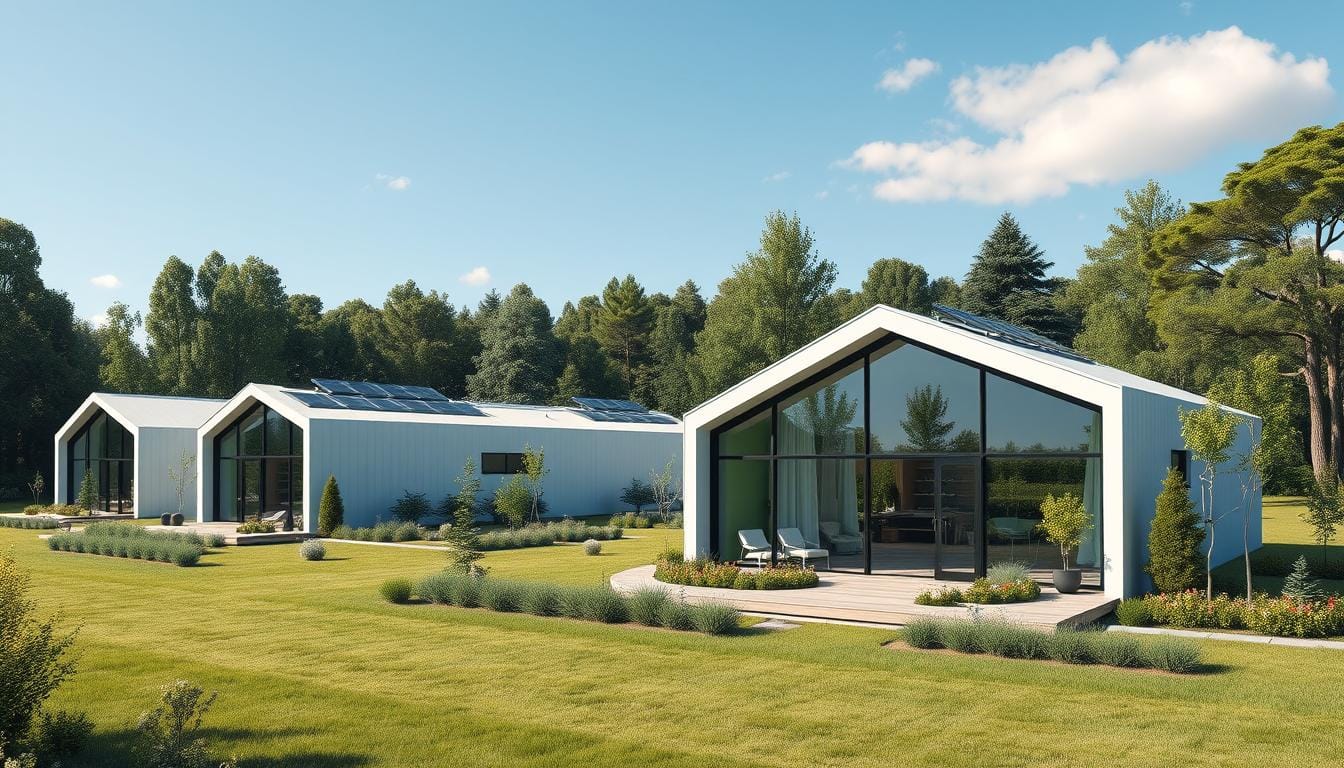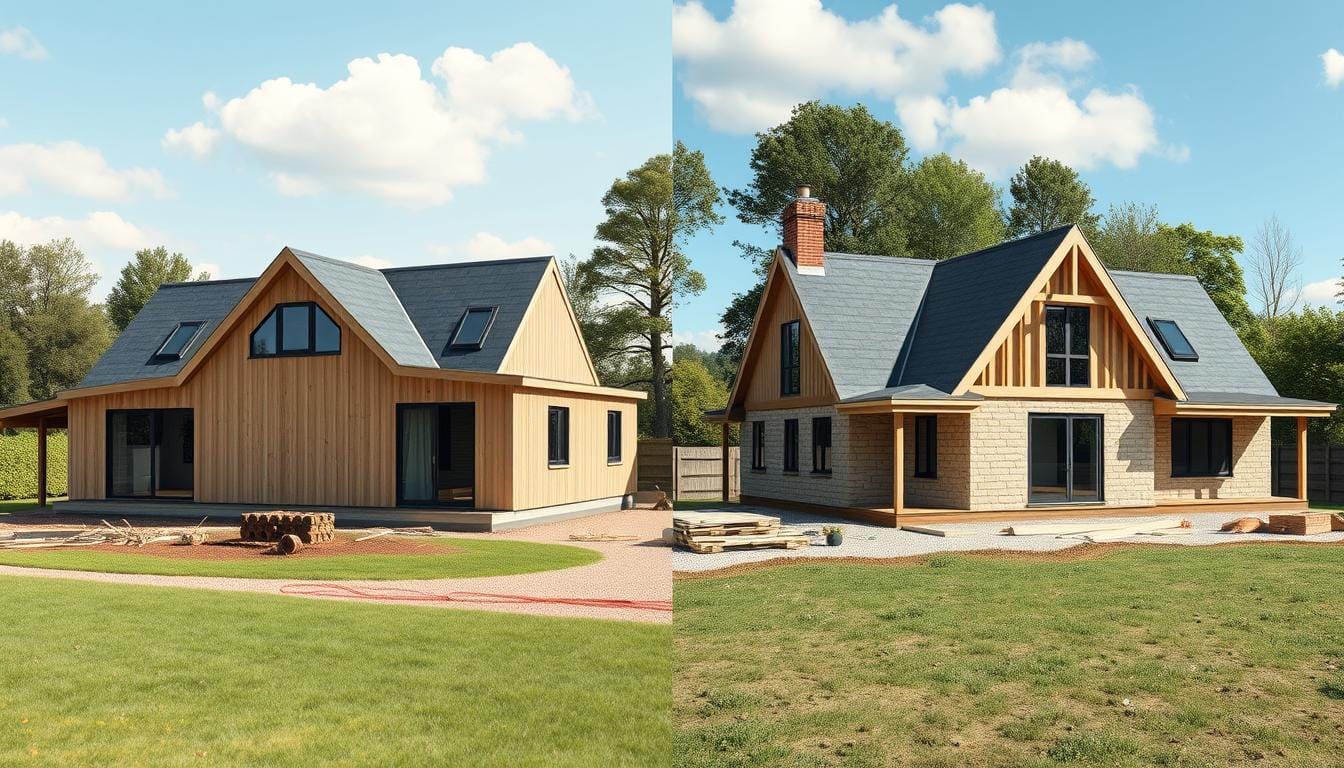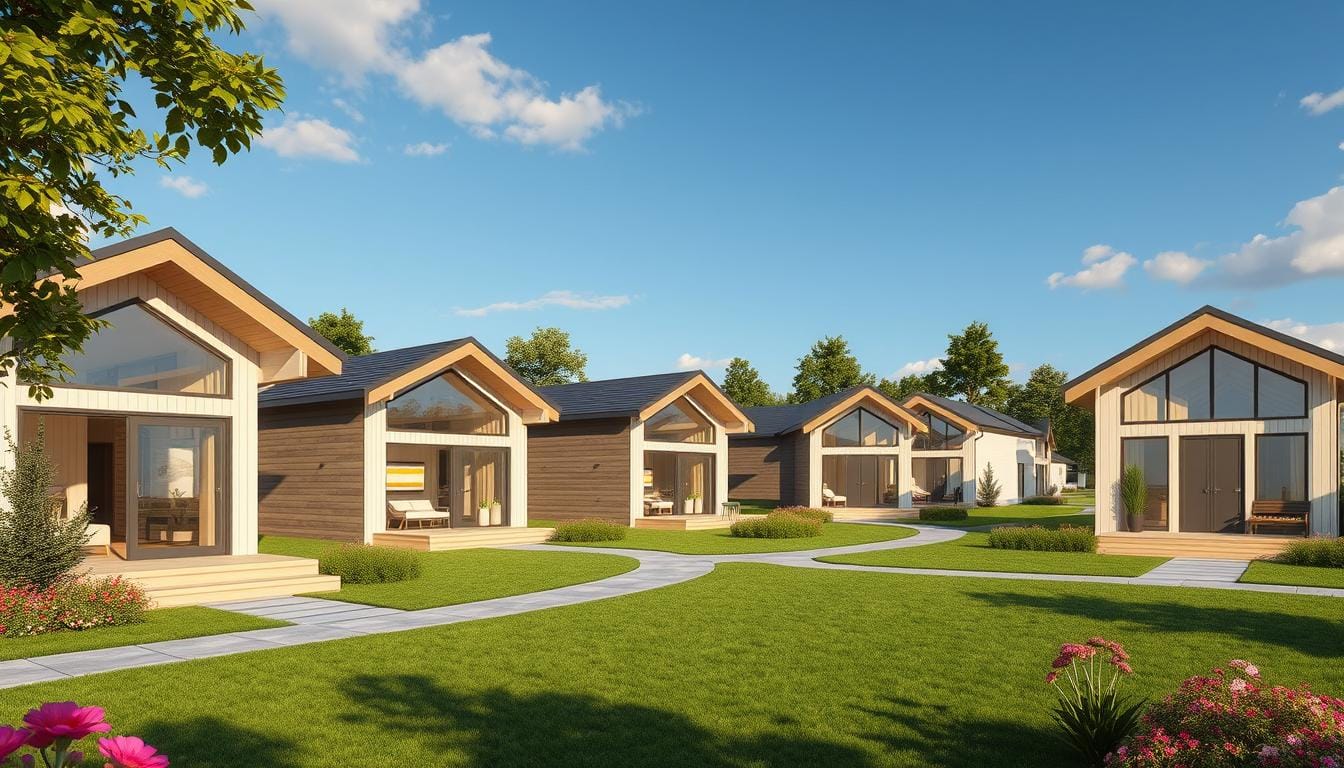Modular homes are known for their strength in bad weather. They are built to withstand high speeds and crane lifts, which mimic extreme weather. This makes them more durable than traditional homes.
The Federal Emergency Management Agency (FEMA) says modular homes often stay strong after disasters. For example, after Hurricane Andrew, they had less damage than usual homes. This is because of how well they connect to each other.
A test by the Insurance Institute for Business and Home Safety (IBHS) showed this. A home built to current codes fell apart in strong winds. But a modular home with special features only had minor damage. This shows how safe US modular homes are in storms.
The IBHS’s FORTIFIED program helps make homes safer. It has three levels of certification for different risks. Modular homes also have a special feature called the continuous load path. This helps them handle storm stresses better than traditional homes.
Key Takeaways
- Modular homes are designed to endure extreme stresses, simulating severe weather conditions.
- FEMA reports highlight superior modular home performance during natural disasters like Hurricane Andrew.
- IBHS tests show that modular homes with enhancements hold together better during high wind events compared to standard homes.
- Programmes like IBHS’s FORTIFIED help ensure modular homes can withstand extreme weather.
- The continuous load path in modular homes is critical for storm stress resistance, often missing in traditional homes.
Understanding Modular Homes and Their Design Principles
Modular homes are a smart choice for those wanting durable, efficient, and custom homes. They are built in factories, ensuring quick assembly and strict safety standards.
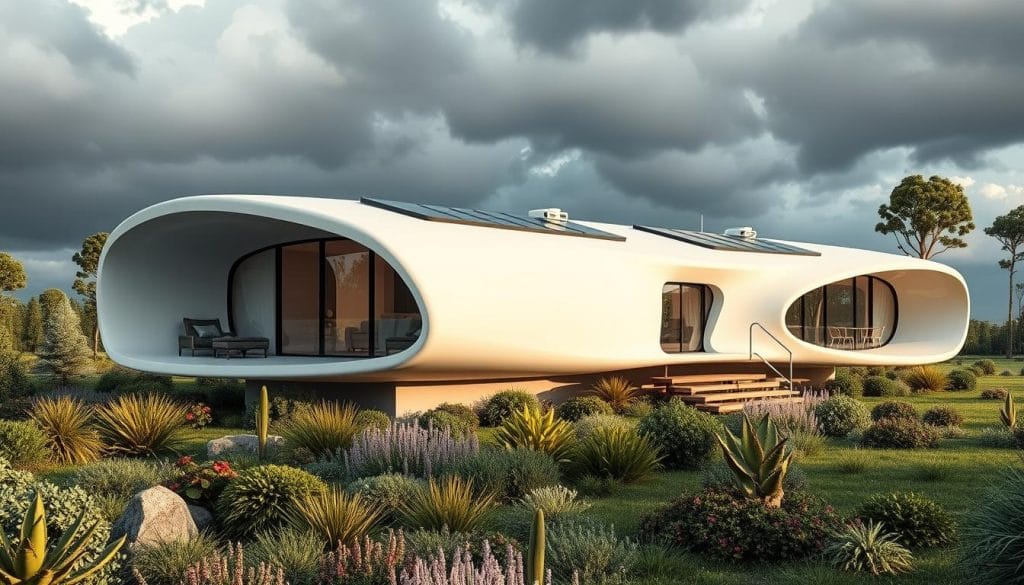
The Concept of Modular Construction
Modular homes are built in sections in a factory. This method guarantees quality and saves time, as it’s not affected by weather. You can customise your home with features like ceramic floors and various wood species.
Building in a factory also means less waste and site disruption. Once ready, the modules are moved and put together on-site. This way, a home is built in weeks, not months.
Key Safety Features in Modular Homes
Safety is a top priority in modular homes. They are built to withstand transport and installation, meeting or exceeding building codes. Key safety features include:
- Continuous Load Path: This ensures the home’s parts are securely connected, handling forces like wind and earthquakes.
- Storm-Resistant Designs: Modular homes often have features like TallWall sheathing to strengthen structures. These designs are tested to withstand extreme weather.
- High-Quality Materials: Modular homes use top-notch materials, like wood and granite, similar to traditional homes.
These features make modular homes safe and reliable, perfect for areas with harsh weather.
Modular homes offer many benefits. They are built fast, can be customised, and are safe. They are a great choice for modern homes, focusing on safety and resilience.
Storm Risks and Their Impact on Homes
Our climate is changing, and we must understand the storms that threaten our homes. We need prefab houses that can resist hurricanes and tornado-proof modular homes to protect us.
Common Storm Types Affecting Homes
Hurricanes, tornadoes, and high winds are major threats. They can cause a lot of damage to homes, unless they are built to high standards. For example, prefab houses made to resist hurricanes can handle the strong winds and heavy rains.
Hurricanes mainly hit coastal areas, causing flooding. In the U.S., over 6.5 million homes along the coasts are at risk, with a cost of nearly $1.5 trillion. Florida is most at risk, with 2.5 million homes and $490 billion in possible damage.
Tornadoes are less common but very destructive. Modular homes built to withstand tornadoes offer better protection than traditional houses. Tornadoes can destroy mobile home parks, showing how vulnerable older homes are. More information is available here.
High winds also pose a threat, mainly to homes not built to current codes. Older mobile homes and those not anchored well are at higher risk.
Historical Storm Data in the UK
In the UK, storms have become more frequent and intense over the years. This highlights the need for better building standards and preparing homes for storms.
These changes have led to new, stronger prefab houses. They are designed to withstand storms and have pushed for stricter building practices.
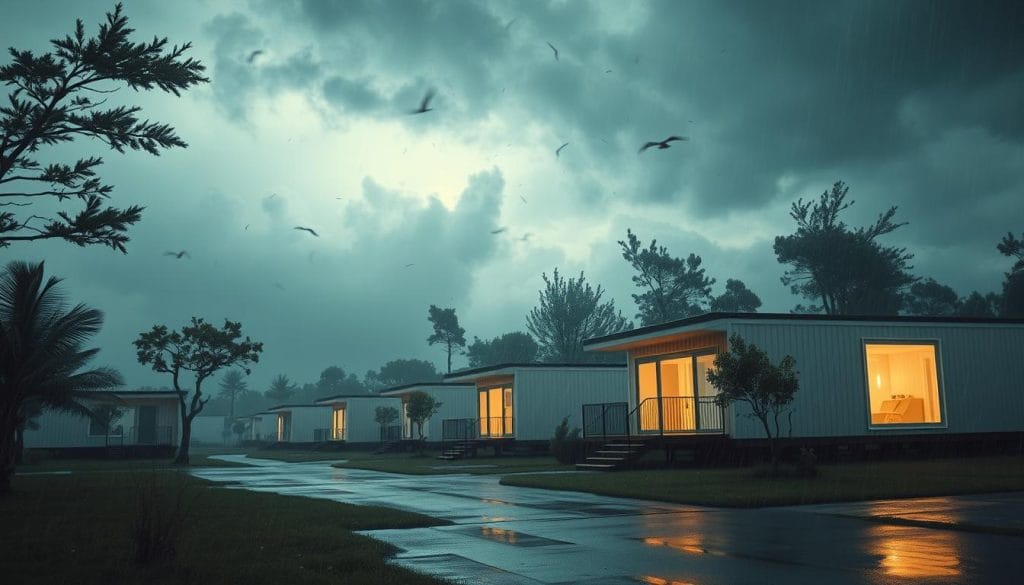
To prevent tornado damage, installing home shelters or practicing safety plans is key. Safe rooms, built to withstand tornadoes, offer almost equal protection.
For a list of places to buy modular homes with storm protection, visit this marketplace.
Building Standards and Regulations for Modular Homes
Understanding regional building standards is key when looking at modular housing rules. In the UK, modular homes must meet strict national standards for safety and quality. These rules cover everything from how strong the structure is to how well it keeps heat in, ensuring homes are safe and perform well.
In the United States, modular building standards are also strict. They combine national codes with specific state rules. This ensures homes are safe and meet local needs.
Overview of UK Building Regulations
UK standards for modular homes aim to ensure they are safe and last long. Important areas include:
- Structural stability to withstand environmental stresses
- Fire safety measures, including fire-resistant materials and proper installation of fire sprinklers
- Thermal performance and energy efficiency
- Sound insulation to prevent noise pollution
- Accessibility and adaptability for diverse resident needs
Recently, the UK has been strict about following these standards. This shows the country’s dedication to building homes that are green and safe.
Comparison with American Standards
While American modular home standards are similar to the UK’s, they also have some differences. Both focus on international safety standards in modular construction, but there are regional adaptations:
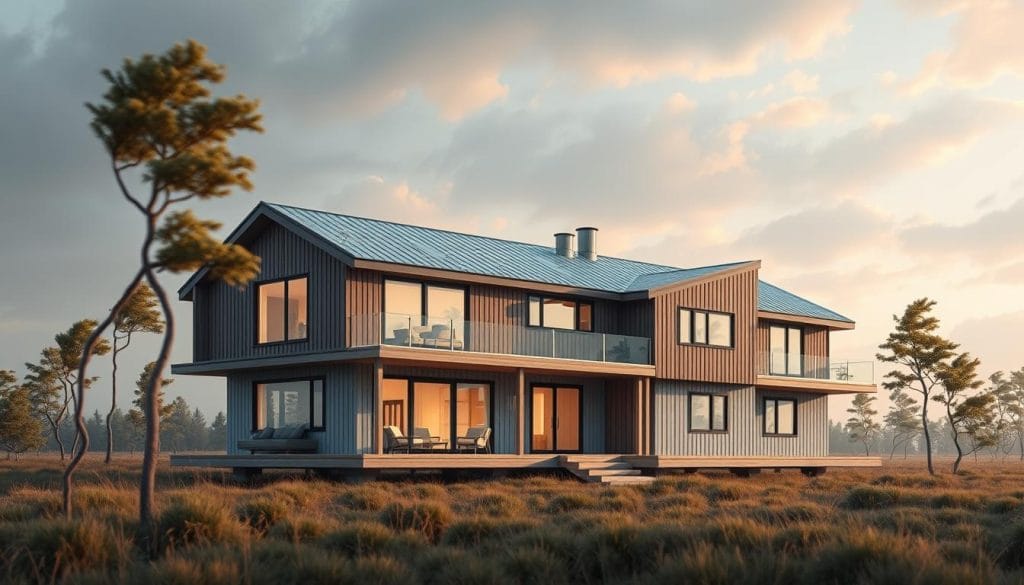
- Fire Safety: The U.S. standards, governed by HUD, include specific codes like § 3280.214 that mandate water supply pressure testing and certification by a fire protection technician during installation.
- Storm Resilience: American standards often incorporate more detailed guidelines for tornado and hurricane resistance, reflective of the higher frequency of such events in certain parts of the U.S.
- Energy Efficiency: Both UK and American codes require high energy efficiency, yet the methodologies for achieving these standards can vary.
- Manufacturing and Transportation: Given the vast distances often involved in the U.S., regulations also focus on minimizing risks during transportation and off-site construction stages.
Even though UK and American modular housing rules aim for the same goals, there are regional differences. These differences help meet local environmental and logistical challenges.
Best Practices for Storm Preparedness
It’s vital to prepare for extreme weather to protect your modular home and family. Knowing how to stay safe during storms is key. This knowledge helps you face severe weather better.
Essential Safety Measures for Homeowners
There are important steps to take to protect your home from storms. Homeowners should:
- Secure loose items that could become projectiles during high winds.
- Install storm shutters or impact-resistant windows and doors.
- Reinforce garage doors to withstand heavy winds.
- Ensure all construction meets or exceeds local building codes for wind and storm resistance.
In hurricane-prone areas like Florida, specific rules apply. These include outward-opening doors and secure framing. Trimming trees and bushes also helps prevent damage.
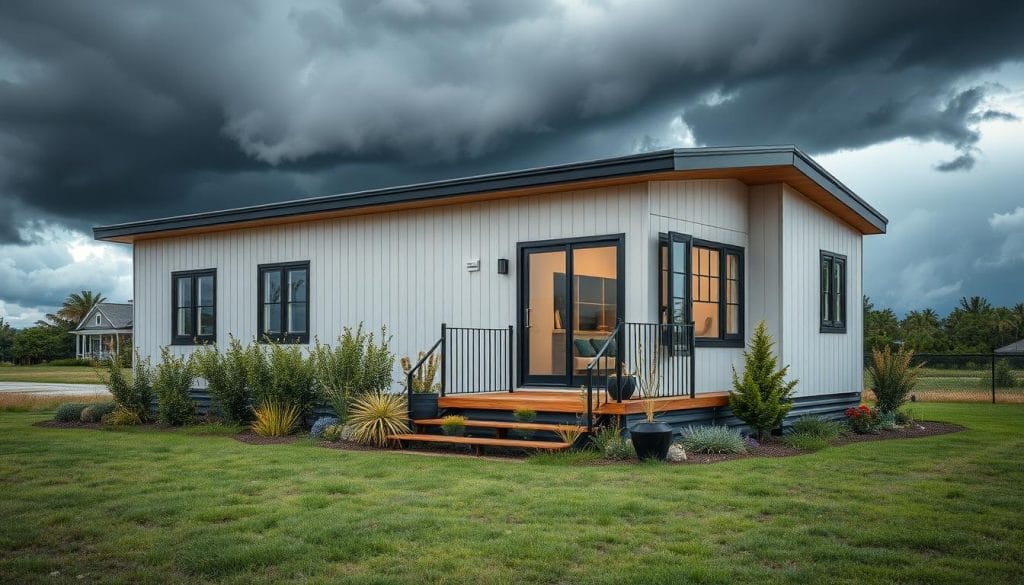
It’s also wise to prepare an emergency kit. Include cell phones, chargers, money, identification, medications, and other essentials. This kit is vital if you need to evacuate.
Community Resources and Support
Community support is essential for storm resilience. Local authorities and groups offer important help and information.
Community resources include:
- Emergency communication plans ensuring multiple ways to stay informed.
- Clear evacuation routes and safe assembly points away from hazards.
- Regular training sessions and exercises to familiarise residents with emergency protocols.
- Access to emergency supplies like first aid kits, fire extinguishers, flashlights, and non-perishable food.
Building relationships with local emergency services before disasters is also beneficial. Regularly update and review disaster plans, too. This is important before high-risk seasons like hurricane or wildfire season.
By following these best practices, homeowners can better prepare for storms. This improves their resilience within the community.
Innovations in Modular Home Design for Storm Safety
Storms are becoming more common and intense. This has led to big changes in how homes are built. Now, builders use new materials and tech to make homes strong against bad weather. They use special windows, walls, and anchoring systems to keep homes safe.
Advanced Materials and Technology
Using new materials is key in building safe homes. Deltec Homes makes homes with strong frames for a good price. Ocala Custom Homes builds homes that can handle winds up to 200 mph, also at a good price.
Companies like AiDomes make homes with thick insulation. This makes homes not only affordable but also very strong. These homes are great for saving money and staying safe.
Future Trends in Modular Construction
The future of building homes safe from storms includes smart tech and green practices. Smart systems can warn homeowners about storms. They also use materials like bamboo and sustainable timber.
These homes are not just safe but also good for the planet. They use less energy and are better for the environment. This is a big step towards a greener future.
Companies like Architects Avenue are leading the way with new ideas. They use apps to help people find homes that fit their needs. This makes finding safe homes easier and more accessible.
In short, the focus on new tech and green building will keep making homes safer and more eco-friendly. This is good news for our future homes.


